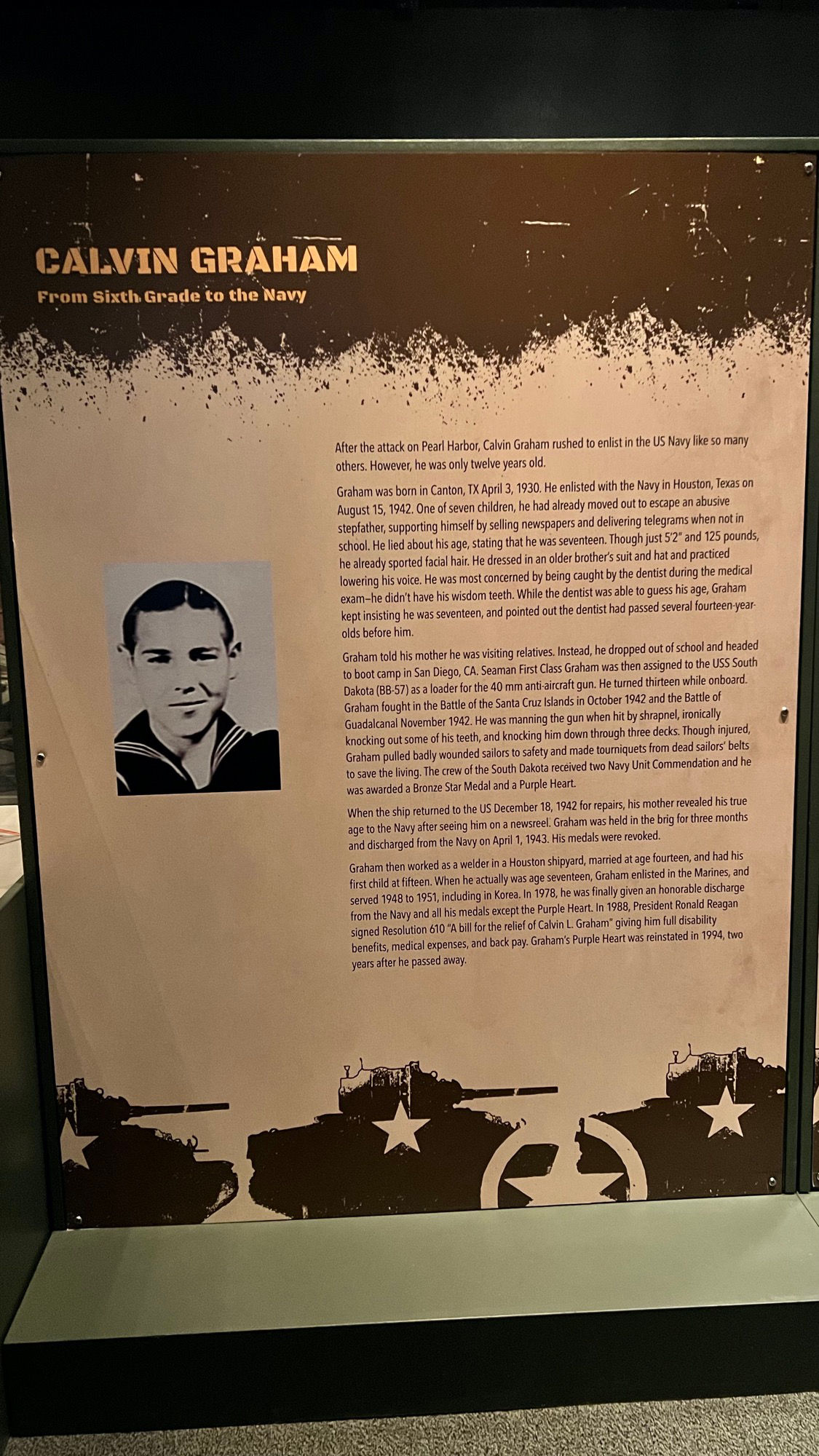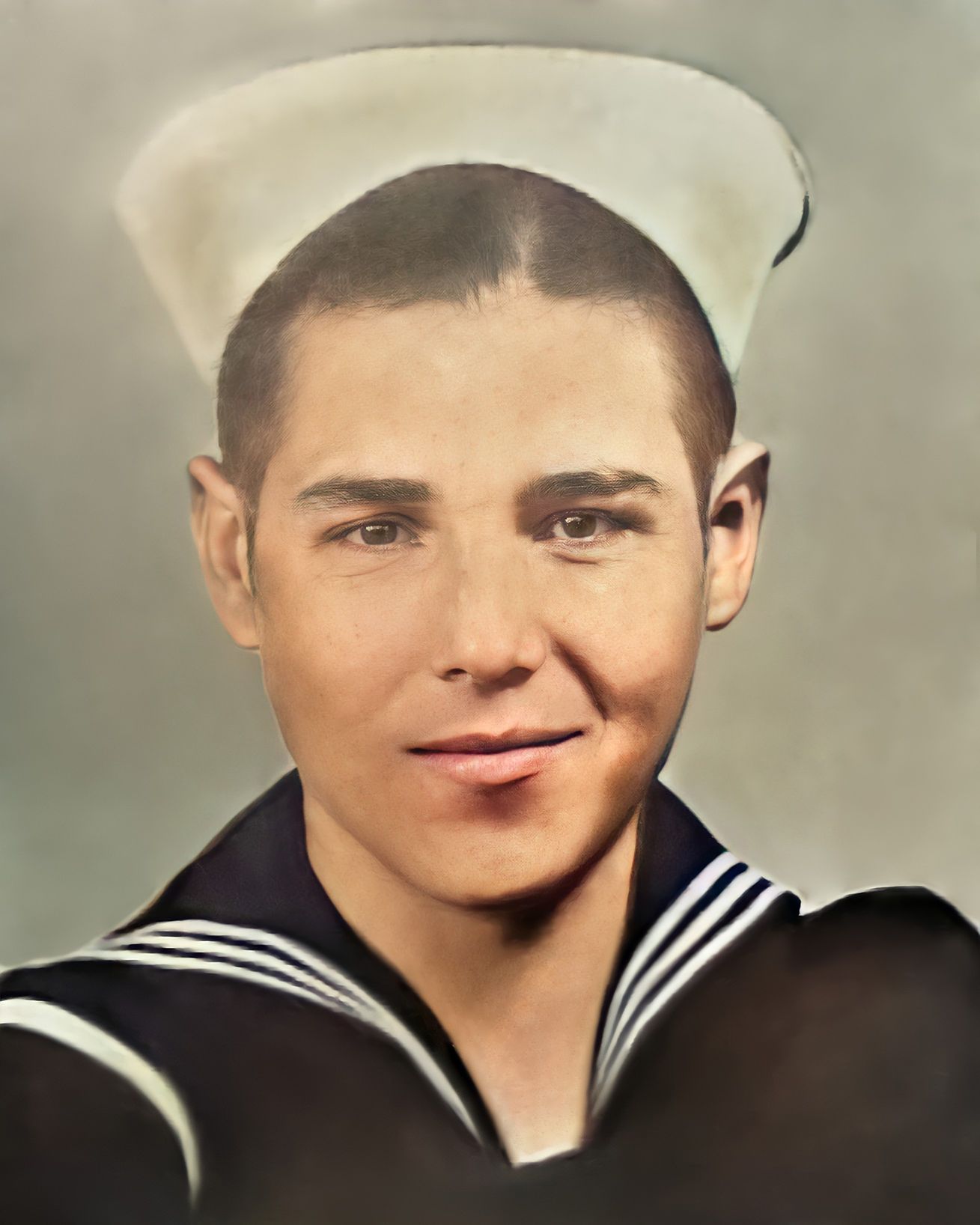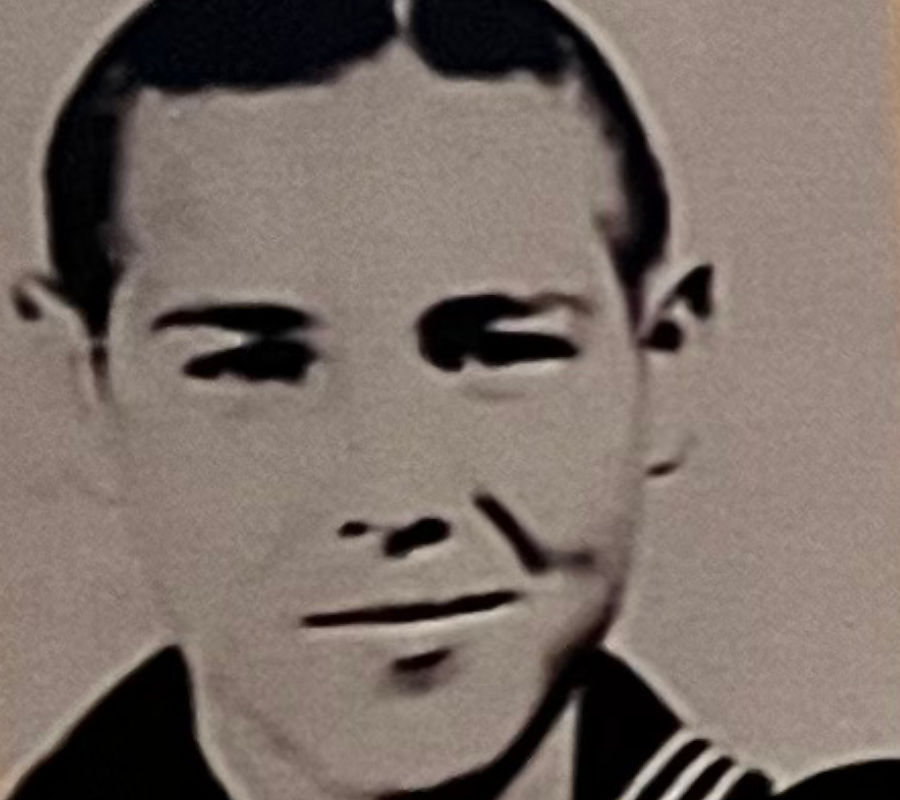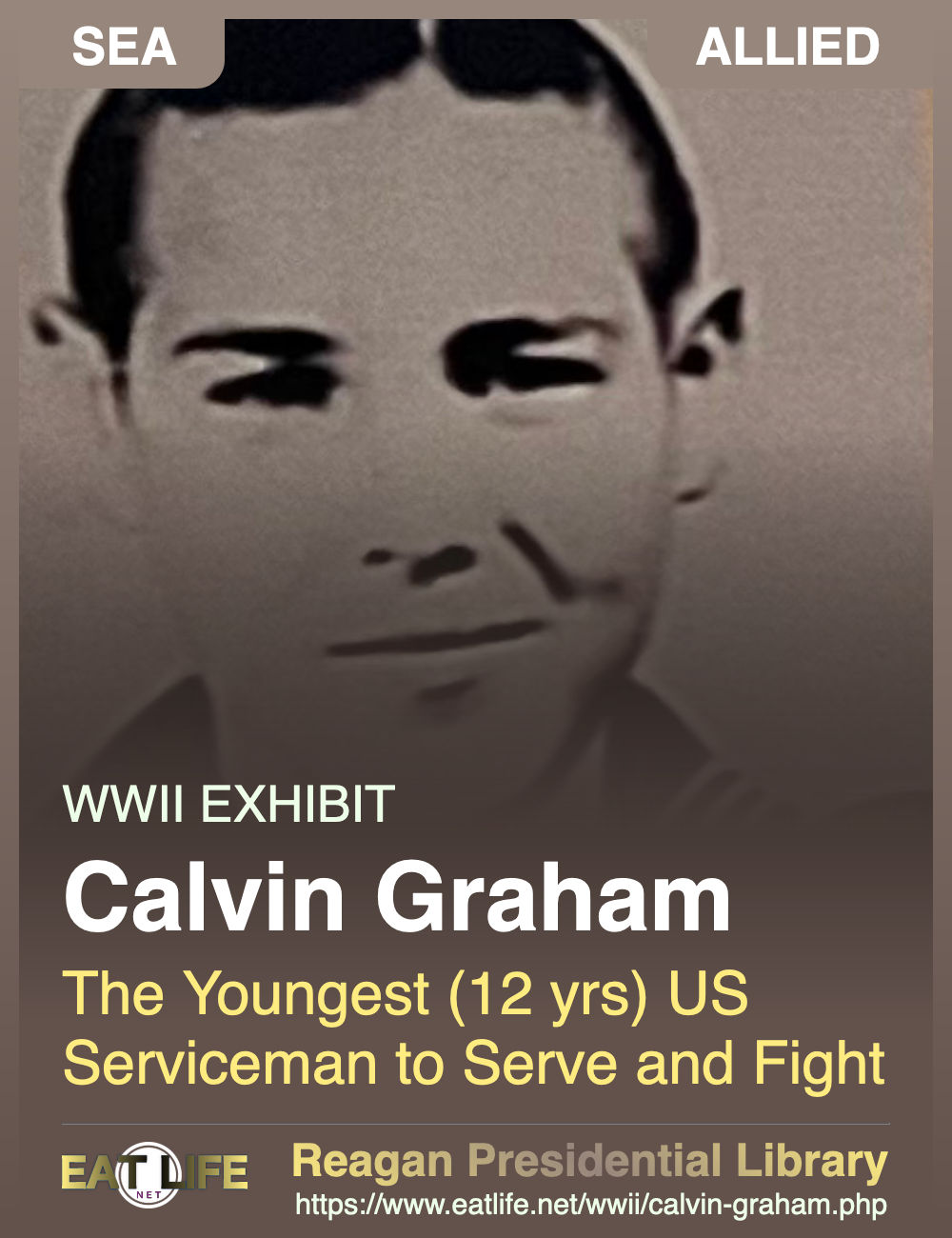
Calvin Graham
From Sixth Grade to the Navy
After the attack on Pearl Harbor, Calvin Graham rushed to enlist in the US Navy like so many others. However, he was only twelve years old.
Graham was born in Canton, TX April 3, 1930. He enlisted with the Navy in Houston, Texas on August 15, 1942. One of seven children, he had already moved out to escape an abusive stepfather, supporting himself by selling newspapers and delivering telegrams when not in school.
- He lied about his age, stating that he was seventeen.
- Though just 52" and 125 pounds, he already sported facial hair.
- He dressed in an older brother's suit and hat and practiced lowering his voice.
- He was most concerned by being caught by the dentist during the medical exam - he didn't have his wisdom teeth.
- While the dentist was able to guess his age, Graham kept insisting he was seventeen, and pointed out the dentist had passed several fourteen - year olds before him.
Graham told his mother he was visiting relatives. Instead, he dropped out of school and headed to boot camp in San Diego, CA. Seaman First Class Graham was then assigned to the USS South Dakota (BB-57) as a loader for the 40 mm anti-aircraft gun. He turned thirteen while onboard.
Graham fought in the Battle of the Santa Cruz Islands in October 1942 and the Battle of Guadalcanal November 1942. He was manning the gun when hit by shrapnel, ironically knocking out some of his teeth, and knocking him down through three decks. Though injured, Graham pulled badly wounded sailors to safety and made tourniquets from dead sailors' belts to save the living. The crew of the South Dakota received two Navy Unit Commendation and he was awarded a Bronze Star Medal and a Purple Heart.
When the ship returned to the US December 18, 1942 for repairs, his mother revealed his true age to the Navy after seeing him on a newsreel. Graham was held in the brig for three months and discharged from the Navy on April 1, 1943. His medals were revoked.
Graham then worked as a welder in a Houston shipyard, married at age fourteen, and had his first child at fifteen. When he actually was age seventeen, Graham enlisted in the Marines, and served 1948 to 1951, including in Korea. In 1978, he was finally given an honorable discharge from the Navy and all his medals except the Purple Heart. In 1988, President Ronald Reagan signed Resolution 610 "A bill for the relief of Calvin L. Graham" giving him full disability benefits, medical expenses, and back pay. Graham's Purple Heart was reinstated in 1994, two years after he passed away.
November 10, 1988
I have today approved H.R. 610, "An Act for the relief of Calvin L. Graham." Mr. Graham is a veteran of Navy and Marine Corps service who has honorably served his country.Section 1 of the Act provides that, for purposes of service-connected disability compensation, the dental injuries that Mr. Graham incurred in the Battle of Guadalcanal will be considered to be a permanent service-connected disability incurred in the line of duty. Section 1 also provides for reimbursement of Mr. Graham for costs he incurred for the treatment of those injuries.
Section 2 of the Act provides for a total lump-sum payment of $4,916.99 to Mr. Graham. That amount represents back pay, mustering-out pay, and interest. Section 2(b) of the Act provides that the payment of the $4,916.99 shall be in full satisfaction of any claim against the United States that Mr. Graham may have for basic pay for the period from September 17, 1942, through April 5, 1943, and for mustering-out pay with respect to his separation from service on April 5, 1943.
Ronald Reagan
The White House,
No
vember 10, 1988.
Note: H.R. 610, approved November 10, was assigned Private Law No. 100 - 44.
Date 11/10/1988
WIKIPEDIACalvin Leon Graham
April 3, 1930 – November 6, 1992
Was the youngest U.S. serviceman to serve and fight during World War II and was one of the few known child soldiers to fight on behalf of the United States in the conflict.Graham was born in Canton, Texas, and was attending elementary school in Houston before he decided to join the Navy, after his father had died and his mother had remarried.
Following the attack on Pearl Harbor, he enlisted in the United States Navy from Houston, Texas on August 15, 1942, at the age of 12. He went through boot camp in San Diego, California for six weeks. He was deployed to the USS South Dakota, at Pearl Harbor in Oahu, Hawaii.
On October 26, 1942, he saw action in the Battle of the Santa Cruz. The South Dakota and her crew received a Navy Unit Commendation for their service. On the night of November 14–15, 1942, Graham was wounded during the Naval Battle of Guadalcanal. He served as a loader for a 40 mm anti-aircraft gun and was hit by shrapnel while taking a hand message to an officer. Though he received fragmentation wounds, he helped in rescue duty by aiding and pulling the wounded aboard ship to safety. He was awarded the Bronze Star Medal and the Purple Heart, and he and his crewmates were awarded another Navy Unit Commendation.
The South Dakota returned to the East Coast on December 18, 1942, for an overhaul and battle damage repairs (she had taken 42 hits from at least three enemy ships) in New York City, and since then, was named "Battleship X" in order to make the Japanese think she had been sunk. Graham's mother revealed his age after he traveled to his grandmother's funeral in Texas (he arrived a day late) without permission from the Navy, for which he spent three months in a Texas brig. He was released after his sister threatened to contact the newspapers. Although he had tried to return to his ship, he was discharged from the Navy on April 1, 1943, and his awards were revoked.
- He then worked in a Houston shipyard as a welder after dropping out of school.
- At age 14 he married and became a father the following year.
- Graham joined the United States Marine Corps in 1948 at age 17. He was divorced when he enlisted. His enlistment in the Marines also ended early when he fell from a pier and broke his back in 1951 during the Korean war.
- In 1978, Graham was finally given an honorable discharge for his service in the Navy.
- With the approval of President Jimmy Carter, all medals except his Purple Heart were reinstated.
- His story came to public attention in 1988, when his story was told in the TV movie, Too Young the Hero starring Rick Schroder.
- In 1988, Graham received disability benefits and back pay for his service in the Navy after President Ronald Reagan signed legislation that granted Graham full disability benefits.
- Graham's Purple Heart was finally reinstated, and presented to his widow, Mary, on June 21, 1994, by Secretary of the Navy John Dalton in Arlington, Texas, nearly two years after his death from heart failure.
- He was buried at Laurel Land Memorial Park in Fort Worth, Texas.
Find a GraveToo Young the Hero
Subject of the movie, "Too Young the Hero." Possibly the nation's youngest combat veteran. Calvin, at age 12 faked his age and joined the Navy in 1942. He fought the WWII bloody battle of Guadalcanal aboard the battleship South Dakota and won the Purple Heart, Bronze Star and other medals for bravery.When it was learned he had lied about his age to enlist, he was thrown in the brig, stripped of his combat medals and denied an honorable discharge. At age 17, he legally enlisted in the United States Marine Corps, serving from 1948-1951 achieving the rank of Corporal until a fall that broke his back permanently ended his military career. After years of lobbying, he finally reclaimed all his medals but the Purple Heart, which was given to his widow in 1994.

Calvin Leon Graham (April 3, 1930 – November 6, 1992) was the youngest U.S. serviceman to serve and fight during World War II. Following the attack on Pearl Harbor, he enlisted in the United States Navy from Houston, Texas on August 15, 1942, at the age of 12.Calvin L. Graham, who gained attention as the boy who lied so he could enlist in the Navy at age 12 during World War II, died Friday in his house in Fort Worth. He was 62 years old. He died of heart failure, said his stepson, Ronnie O'Donley
- Birth
3 Apr 1930
Canton, Van Zandt County, Texas, USA- Death
6 Nov 1992 (aged 62)
Fort Worth, Tarrant County, Texas, USA- Burial
Laurel Land Memorial Park
Fort Worth, Tarrant County, Texas, USA










